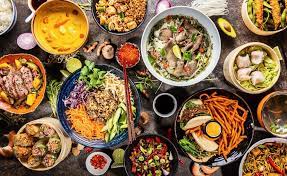Chinese cuisine is known for its rich, diverse flavors and unique cooking techniques. From fiery Sichuan dishes to delicate Cantonese dim sum, the culinary traditions of China have captivated food enthusiasts around the world. In this article, we will delve into the vibrant world of traditional Chinese food, exploring its regional diversity, key ingredients, and iconic dishes.
Regional Diversity
China’s vast landmass and varied climates have given rise to a remarkable culinary diversity, with each region boasting its own distinct flavors and cooking styles.
Sichuan Province: Renowned for its bold, spicy flavors, Sichuan cuisine incorporates the famous Sichuan peppercorn, which lends a numbing, tingling sensation to many dishes. Classic Sichuan dishes include Mapo Tofu, Kung Pao Chicken, and Sichuan Hot Pot.
Cantonese Cuisine: Hailing from the southern province of Guangdong, Cantonese cuisine emphasizes fresh ingredients and subtle, natural flavors. Dim sum, barbecued meats, and delicate stir-fried dishes are hallmarks of this regional cuisine.
Shandong Province: Known for its seafood and hearty, savory flavors, Shandong cuisine features a variety of braised, pan-fried, and deep-fried dishes. The province’s coastal location also influences its abundant use of seafood in culinary creations.
Huaiyang Cuisine: Originating from the Jiangsu province, Huaiyang cuisine is celebrated for its meticulous preparation and delicate presentation. The emphasis on precise knife skills and artistic plating sets Huaiyang dishes apart.
Key Ingredients
Several key ingredients form the foundation of traditional Chinese cuisine, contributing to its distinctive taste profiles and textures.
Soy Sauce: A fundamental seasoning in Chinese cooking, soy sauce adds depth and umami to a wide range of dishes, from stir-fries to braises.
Ginger and Garlic: These aromatic ingredients are often used together to infuse dishes with robust, savory flavors.
Five-Spice Powder: A fragrant blend of star anise, cloves, cinnamon, Sichuan peppercorns, and fennel seeds, five-spice powder is a cornerstone of many Chinese recipes.
Rice Vinegar: With its mild acidity and subtle sweetness, rice vinegar is a staple in dressings, marinades, and dipping sauces.
Iconic Dishes
Traditional Chinese cuisine boasts a myriad of iconic dishes that have garnered international acclaim for their bold flavors and artistic presentation.
Peking Duck: A symbol of Chinese culinary finesse, Peking Duck is prized for its crispy skin, succulent meat, and indulgent accompanying condiments.
Xiaolongbao: These delicate soup dumplings, hailing from the Jiangnan region, are revered for their thin, delicate skins and flavorful, hot broth fillings.
Kung Pao Chicken: A beloved Sichuan dish, Kung Pao Chicken features tender, succulent chicken morsels stir-fried with peanuts, chili peppers, and aromatic spices.
Hot Pot: A communal dining experience, hot pot involves simmering various meats, seafood, and vegetables in a flavorful broth at the dining table, allowing for a customizable feast.
Conclusion
Chinese food is a treasure trove of flavors, textures, and culinary traditions. Whether you’re a fan of spicy Sichuan dishes or prefer the delicate flavors of Cantonese cuisine, there is something for everyone to enjoy. Exploring the regional variations and popular dishes of Chinese cuisine allows us to appreciate the rich cultural heritage and culinary expertise that goes into each plate. So, the next time you crave a taste of China, venture into a local Chinese restaurant or try your hand at cooking an authentic Chinese recipe at home. Happy eating!



